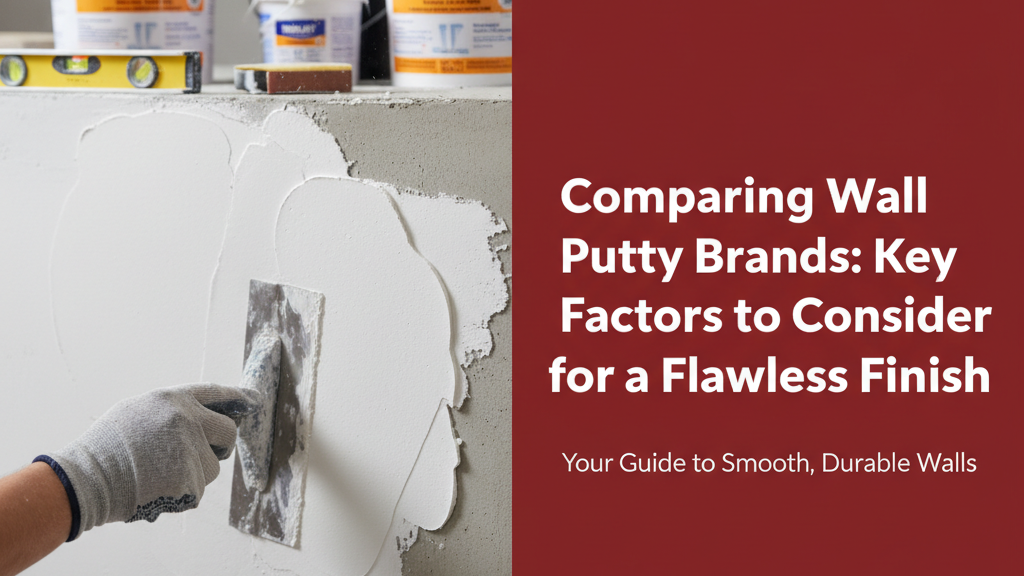Understanding Wall Putty and Its Importance
Wall putty acts as a protective layer between your walls and paint, creating a smooth surface for flawless finishes. In India’s humid and dusty conditions, quality putty prevents cracks, moisture damage, and fungal growth—common issues affecting plaster and paint longevity. A well-chosen putty enhances paint adhesion, reduces uneven textures, and maintains wall aesthetics for years.
Key Factors to Compare Wall Putty Brands
When evaluating wall putty brands, consider these critical aspects:
- Base Material: Acrylic, cement-based, or white cement variants offer different adhesion and flexibility.
- Particle Fineness: Fine particles (under 90 microns) ensure smoother application and fewer streaks.
- Drying Time: Typically 4-6 hours per coat; faster drying in humid climates can prevent moisture trapping.
- Compatibility: Must bond well with underlying plaster and topcoat paints (emulsion, enamel, etc.).
Finishing Quality and Smoothness
A premium putty leaves walls uniformly smooth with minimal sanding effort. Indicators of superior finish:
| Feature | Good Quality | Average Quality |
|---|---|---|
| Surface Texture | Velvet-like, even after drying | Grainy or patchy areas |
| Sanding Required | Light sanding (120-150 grit) | Aggressive sanding needed |
| Paint Coverage | 20-25% paint savings | Higher paint consumption |
Putties with polymer additives reduce micro-cracks during thermal expansion, crucial for regions with 30–45°C temperature swings.
Durability and Longevity
Durable putty resists common degradation factors:
- Moisture Resistance: ISO-certified putties withstand 85–95% humidity without blistering.
- Alkali Resistance: Prevents efflorescence (white salt deposits) on walls.
- Adhesion Strength: Should exceed 1.5 N/mm² to avoid peeling in monsoon seasons.
In coastal areas like Mumbai or Chennai, opt for putty with corrosion inhibitors to counter salt-laden air.
Ease of Application
User-friendly putty simplifies the process:
- Mixing: Pre-mixed variants save time; powdered types should blend smoothly without lumps.
- Application: Should spread evenly with a trowel—neither too sticky nor too runny.
- Repairability: Allows spot fixes without full reapplication.
Low-dust formulations are safer for indoor use and reduce post-application cleanup.
Cost vs. Value for Money
Balance initial cost with long-term benefits:
- Coverage: Premium brands often cover 12–14 sq.m/kg (2 coats) vs. 8–10 sq.m/kg for economy options.
- Maintenance Cycles: High-quality putty extends repainting intervals by 2–3 years.
- Wastage: Inferior putty requires thicker coats, increasing material use by 15–20%.
Top Wall Putty Brands in the Market
Leading Indian brands meet different needs:
| Brand Type | Best For | Key Advantage |
|---|---|---|
| White Cement-Based | High-moisture areas | Superior water resistance |
| Acrylic | Smooth finishes | Elasticity reduces cracks |
| Polymer-Modified | Extreme climates | Thermal stability |
How to Choose the Right Wall Putty for Your Needs
Match putty to your specific conditions:
- New Construction: Cement-based putty for strong substrate bonding.
- Renovations: Acrylic putty for flexibility over existing cracks.
- Bathrooms/Kitchens: Fungal-resistant variants with moisture barriers.
Final Thoughts on Selecting the Best Wall Putty
A meticulous comparison based on your regional climate, wall substrate, and desired finish ensures optimal results. Prioritise putties that align with ISI standards for material safety and performance consistency. While cost is a factor, investing in quality putty reduces long-term maintenance expenses and preserves wall integrity.



